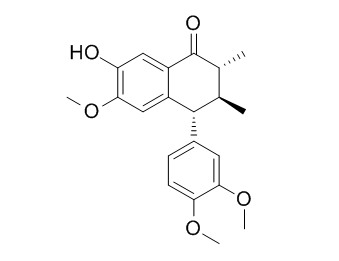Epischisandrone
Reference standards.
Inquire / Order:
manager@chemfaces.com
Technical Inquiries:
service@chemfaces.com
Tel:
+86-27-84237783
Fax:
+86-27-84254680
Address:
1 Building, No. 83, CheCheng Rd., Wuhan Economic and Technological Development Zone, Wuhan, Hubei 430056, PRC
Providing storage is as stated on the product vial and the vial is kept tightly sealed, the product can be stored for up to
24 months(2-8C).
Wherever possible, you should prepare and use solutions on the same day. However, if you need to make up stock solutions in advance, we recommend that you store the solution as aliquots in tightly sealed vials at -20C. Generally, these will be useable for up to two weeks. Before use, and prior to opening the vial we recommend that you allow your product to equilibrate to room temperature for at least 1 hour.
Need more advice on solubility, usage and handling? Please email to: service@chemfaces.com
The packaging of the product may have turned upside down during transportation, resulting in the natural compounds adhering to the neck or cap of the vial. take the vial out of its packaging and gently shake to let the compounds fall to the bottom of the vial. for liquid products, centrifuge at 200-500 RPM to gather the liquid at the bottom of the vial. try to avoid loss or contamination during handling.
iScience.2024, 4790628.
J Agric Food Chem.2017, 65(13):2670-2676
LWT2021, 138:110397.
Nutrients.2023, 15(4):950.
Rev. Chim.2020, 71(3),558-564
Pharm Biol.2021, 59(1):134-145.
J Agric Food Chem.2021, 69(14):4210-4222.
Planta Med.2018, 84(6-07):465-474
Processes2022, 10(10), 2008.
Pharmaceuticals (Basel).2020, 13(10):302.
Related and Featured Products
Pharm Biol. 2013 Sep;51(9):1204-7.
Cytotoxic and potential anticancer constituents from the stems of Schisandra pubescens.[Pubmed:
23883077 ]
The diethyl ether extract of the stems of Schisandra pubescens Hemsl. et Wils. (Schisandraceae) was found to exhibit cytotoxic activity in vitro. However, investigations of the bioactive constituents of this plant have been very limited.
Elucidation of the cytotoxic constituents of S. pubescens was performed.
METHODS AND RESULTS:
Repeated silica gel column chromatography and preparative TLC were used for the chemical investigation of the diethyl ether extract of S. pubescens stems. All isolates were evaluated for their in vitro cytotoxicity against A549, PC-3, KB and KBvin human cancer cell lines.Nine known compounds were obtained, including four lignans, Epischisandrone (1), tigloylgomisin P (2), cagayanone (3) and (-)-gomisin L₂ (4), together with five triterpenoids, micranoic acid B (5), lancifodilactone H (6), coccinic acid (7), schisanlactone B (8) and anwuweizonic acid (9). Compounds 2-6 and 8 showed moderate to marginal cytotoxicity, with GI₅₀ values of 11.83-35.65 μM.
CONCLUSIONS:
The isolation of 1-9 from S. pubescens and the cytotoxicities of 3-6 are first reported. Compounds 2-6 and 8 could be the active principles responsible for the anticancer effects of S. pubescens.
Chem Pharm Bull (Tokyo). 2009 Apr;57(4):405-7.
Two new lignans from Schisandra henryi.[Pubmed:
19336937]
METHODS AND RESULTS:
Two new lignans, henricines A (1) and B (2), were isolated along with the eight known lignans, ganshisandrine (3), wulignan A(2) (4), epiwulignan A(1) (5), deoxyschisandrin (6), wulignan A(1) (7), Epischisandrone (8), schisantherin A (9), and schisandrol A (10), from the stems of Schisandra henryi.
CONCLUSIONS:
The structures of the new compounds were elucidated based on the spectral analysis, including 1D and 2D NMR experiments.



